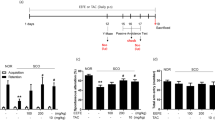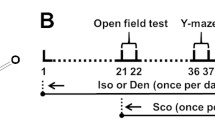Abstract
This paper aimed to elucidate the effect of Erythrina variegata L. bark on scopolamine-induced memory impairment in rats and to decipher the molecular mechanism of phytoconstituents via the utilization of gene set enrichment analysis, network pharmacology coupled with in silico docking study. First, three models i.e. Morris Water Maze (MWM), Elevated Plus Maze (EPM), and Passive Avoidance Paradigm (PA) were utilized to elucidate the memory function. Second, the level of biomarkers i.e. acetylcholinesterase enzyme, reduced glutathione, and lipid peroxidation level were measured in brain tissues. Third, the key bioactive phytoconstituents targeting potential protein targets and pathways were identified through gene set enrichment analysis and network pharmacology. Lastly, the interaction between bioactive phytoconstituents with their respective targets was confirmed by molecular docking analysis. The MWM, EPM, and PA activity showed, scopolamine administration increased Escape Latency Time (ELT), Transfer Latency (TL), and Step Through Latency (STL) respectively on day 0th, 7th, 14th, and 21st, whereas treatment with E. variegata extract significantly reverse the ELT, TL and STL activity. The decreased level of Acetylcholinesterase (AChE) and MDA level in treated animals reflected the enhanced memory and was found to be comparable withclinically proven drug i.e. donepezil. Sixty compounds were identified in EV bark, among which twenty-two compounds are predicted to modulate potential targets involved in AD and considered potentially bioactive. Further, the docking study revealed, Alpinumisoflavone, Auriculatin, Osajin, and Scandenone to have the highest binding affinity with Tau protein, Whereas Donepezil and Glucoerysodine with acetylcholinesterase enzyme.
Graphic abstract





Similar content being viewed by others
References
Ali TB, Schleret TR, Reilly BM, Chen WY, Abagyan R (2015) Adverse effects of cholinesterase inhibitors in dementia, according to the pharmacovigilance databases of the United-States and Canada. PLoS ONE 10:1–10
Bachurin SO, Bovina EV, Ustyugov AA (2017) Drugs in clinical trials for Alzheimer’s disease: the major trends. Med Res Rev 37:1186–1225
Bartus RT, Dean R, Beer B, Lippa AS (1982) The cholinergic hypothesis of geriatric memory dysfunction. Science 217:408–414
Bennett BM, Reynolds JN, Prusky GT, Douglas RM, Sutherland RJ, Thatcher GR (2007) Cognitive deficits in rats after forebrain cholinergic depletion are reversed by a novel NO mimetic nitrate ester. Neuropsychopharmacology 32:505–513
Bhuvanendran S, Kumari Y, Othman I, Shaikh MF (2018) Amelioration of cognitive deficit by embelin in a scopolamine-induced Alzheimer’s disease-like condition in a rat model. Front Pharmacol 9:665
Biovia DS (2019) Discovery studio modeling environment. DassaultSystemes, San Diego
Blennow K, Leon MJ, De Zetterberg H (2006) Alzheimer’s Dis 368:387–403
Chen X, Ji ZL, Chen YZ (2002) TTD: therapeutic target database. Nucleic Acids Res 30:412–415
Chu HB, Tan YD, Li YJ, Cheng BB, Rao BQ, Zhou LS (2019) Anxiolytic and anti-depressant effects of hydroalcoholic extract from Erythrina variegata and its possible mechanism of action. African Health Sci 19(3):2526–2536
De Araújo-Júnior JX, De Oliveira MS, Aquino PG, Alexandre-Moreira MS, Sant’Ana AE (2012) A phytochemical and ethnopharmacological review of the genus Erythrina. InTech. 327–358
Ding M, Ma W, Wang X, Chen S, Zou S, Wei J, Yang Y, Li J, Yang X, Wang H, Li Y (2019) A network pharmacology integrated pharmacokinetics strategy for uncovering pharmacological mechanism of compounds absorbed into the blood of Dan-Lou tablet on coronary heart disease. J Ethnopharmacol 242:112055
Duyu T, Khanal P, Khatib NA, Patil BM (2020) Mimosa pudica modulates neuroactive ligand receptor interaction in Parkinson’s disease. Indian J Pharm Educ Res 54(3):732–739
Ellman GL (1959) Tissue sulfhydryl groups. Arch Biochem Biophys 82:70–77
Ellman GL, Courtney KD, Andres V Jr, Featherstone RM (1961) A new and rapid colorimetric determination of acetylcholinesterase activity. Biochem Pharmacol 7:88–95
Ferreira-Vieira HT, Guimaraes MI, Silva RF, Ribeiro MF (2016) Alzheimer’s disease: targeting the cholinergic system. Curr Neuropharmacol 14:101–115
Gfeller D, Grosdidier A, Wirth M, Daina A, Michielin O, Zoete V (2014) SwissTargetPrediction: a web server for target prediction of bioactive small molecules. Nucleic Acids Res 42:W32–W38
Gribkoff VK, Kaczmarek LK (2017) The need for new approaches in CNS drug discovery: why drugs have failed, and what can be done to improve outcomes. Neuropharmacology 120:11–19
Halgren TA, Merck (1996) Molecular force field. I. Basis, form, scope, parameterization, and performance of MMFF94. J Comput Chem 17:490–519
Hussain G, Rasul A, Anwar H, Aziz N, Razzaq A, Wei W, Ali M, Li J, Li X (2018) Role of plant derived alkaloids and their mechanism in neurodegenerative disorders. Int J BiolSci 14:341
Ishola IO, Ikuomola BO, Adeyemi OO (2018) Protective role of Spondiasmombin leaf and Cola acuminata seed extracts against scopolamineinduced cognitive dysfunction. Alexandria J Med 54:27–39
Jung WY, Kim H, Park HJ, Jeon SJ, Park HJ, Choi HJ, Kim NJ, Jang DS, Kim DH, Ryu JH (2016) The ethanolic extract of the Ecliptaprostrata L. ameliorates the cognitive impairment in mice induced by scopolamine. J Ethnopharmacol 190:165–173
Kanehisa M, Goto S (2000) KEGG: kyotoencyclopedia of genes and genomes. Nucleic Acids Res 28:27–30
Khanal P, Patil BM (2020a) α-Glucosidase inhibitors from Durantarepens modulate p53 signaling pathway in diabetes mellitus. AdvTradit Med (ADTM). https://doi.org/10.1007/s13596-020-00426-w
Khanal P, Patil BM (2020b) Gene ontology enrichment analysis of α-amylase inhibitors from Durantarepens in diabetes mellitus. J Diabetes MetabDisord. https://doi.org/10.1007/s40200-020-00554-9
Khanal P, Mandar BK, Magadum P, Patil BM, Hullatti KK (2019a) In silico docking study of Limonoids from Azadirachta indica with pfpk5: A Novel Target for Plasmodium falciparum. Indian J Pharm Sci 81:326–332
Khanal P, Mandar BK, Patil BM, Hullatti (2019b) In silico antidiabetic screening of Borapetoside C, Cordifolioside A and Magnoflorine. Indian J Pharm Sci 81:550–555
Khanal P, Patil BM, Chand J, Naaz Y (2020) Anthraquinone derivatives as an immune booster and their therapeutic option against COVID-19. Nat Prod Bioprospect 10:325–335. https://doi.org/10.1007/s13659-020-00260-2
Kim S, Thiessen PA, Bolton EE, Chen J, Fu G, Gindulyte A, Han L, He J, He S, Shoemaker BA, Wang J (2016) PubChem substance and compound databases. Nucleic Acids Res 44:D1202–D1213
Kim YR, Kwon MY, Pak ME, Park SH, Baek JU, Choi BT (2018) Beneficial effects of gagam-palmultang on scopolamine-induced memory deficits in mice. Evid-Based Complement Altern Med 8:6–34
Korczyn AD, Vakhapova V (2007) The prevention of the dementia epidemic. J NeurolSci 257:2–4
Laskowski RA, MacArthur MW, Moss DS, Thornton JM (1993) PROCHECK: a program to check the stereochemical quality of protein structures. J Appl Crystallogr 26:283–291
Li P, Liu S, Liu Q, Shen J, Yang R, Jiang B, He C, Xiao P (2019) Screening of acetylcholinesterase inhibitors and characterizing of phytochemical constituents from Dichocarpumauriculatum (Franch.) WT Wang & PK Hsiao through UPLC-MS combined with an acetylcholinesterase inhibition assay in vitro. J Ethnopharmacol 245:112185
Lim TK (2014) Erythrina variegata Edible medicinal and non-medicinal plants, vol 7, 1st edn. Springer, The Netherlands, pp 788–805
Majinda RR (2018) An update of erythrinan alkaloids and their pharmacological activities. ProgChem Org Nat Prod 107:95–159
Mayo clinic (2018) Alzheimer’s: drugs help manage symptoms. https://www.mayoclinic.org/diseases-conditions/alzheimers-disease/indepth/alzheimers/art-20048103. Assessed 05 Dec 2018
Morris GM, Huey R, Lindstrom W, Sanner MF, Belew RK, Goodsell DS, Olson AJ (2009) AutoDock4 and AutoDockTools4: automated docking with selective receptor flexibility. J Comput Chem 30:2785–2791
Ohkawa H, Ohishi N, Yagi K (1979) Assay for lipid peroxides in animal tissues by thiobarbituric acid reaction. Anal Biochem 95:351–358
Palle S, Neerati P (2017) Quercetin nanoparticles attenuates scopolamine-induced spatial memory deficits and pathological damages in rats. Bull Fac Pharmacy Cairo Univ 55:101–106
Patil VS, Biradar PR, Attar V, Khanal P (2019) In silico docking analysis of active biomolecules from Cissus quadrangularis L. against PPAR-γ. Indian J Pharm Educ Res 53:S332–S337
Ramakrishnan P (2015) Cognitive enhancing, anti-acetylcholinesterase, and antioxidant properties of Tagetespatula on scopolamine-induced amnesia in mice. Int J Green Pharm 9:167–174
Shah VV, Shah VK, Sheth NR, Patel MM (2017) Hepatoprotective and anti-inflammatory activities of hydroalcoholic extract of bark of erythrina Indica. RJPPD 9:189–194
Shannon P, Markiel A, Ozier O, Baliga NS, Wang JT, Ramage D, Amin N, Schwikowski B, Ideker T (2003) Cytoscape: a software environment for integrated models of biomolecular interaction networks. Genome Res 13:2498–2504
Szklarczyk D, Gable AL, Lyon D, Junge A, Wyder S, Huerta-Cepas J, Simonovic M, Doncheva NT, Morris JH, Bork P, Jensen LJ (2019) STRING v11: protein–protein association networks with increased coverage, supporting functional discovery in genome-wide experimental datasets. Nucleic Acids Res 47:D607–D613
Ternikar SG, Patil M, Pasha I, Khanal P (2020) Gene set enrichment analysis of α-amylase and α-glucosidase inhibitors of Cassia glauca. J Diabetes MetabDisord. https://doi.org/10.1007/s40200-020-00538-9
Tung BT, Hai NT, Thu DK (2017) Antioxidant and acetylcholinesterase inhibitory activities in vitro of different fraction of Huperziasquarrosa (Forst.) Trevis extract and attenuation of scopolamine-induced cognitive impairment in mice. J Ethnopharmacol 198:24–32
Uddin MS, Asaduzzaman M, Mamun AA, Iqbal MA, Wahid F, Rony RK (2016) Neuroprotective activity of Asparagus racemosus Linn. against ethanol-induced cognitive impairment and oxidative stress in rats brain: auspicious for controlling the risk of Alzheimer’s disease. J Alzheimers Dis Parkinsonism 6:245
Ulep MG, Saraon SK, Mclea S (2017) Alzheimer disease. TJNP J Nurse Pract 14:129–135
Acknowledgement
The authors thank the Vital Laboratories Pvt. Ltd, Gujarat for providing Scopolamine HBr and Apotex pharmaceuticals, Bangalore for providing Donepezil as a gift sample. Thanks to the Principal KLE College of Pharmacy, Belagavi for providing necessary facilities to conduct the work.
Funding
None
Author information
Authors and Affiliations
Contributions
Prakash Biradar designed the study, conducted the experiments and written and drafted the manuscript Vishal Patil performed insilico studies and data analysis. Dr. Hanumanthachare Joshi supervised the experiments. Pukar Khanal and Shamanand Mallapur assisted in data analysis and reviewed the manuscript.
Corresponding author
Ethics declarations
Ethical statement
The study protocol was reviewed and approved by the Institutional Animal Ethical Committee, KLE College of Pharmacy, Belagavi, and Resolution No. KLECOP/CPCSEAReg. No. 221/Po/Re/S/2000/CPCSEA, Res. 25–13/10/2018. The animal experiments were carried out in accordance with the CPCSEA guidelines.
Conflict of interest
All the authors of this manuscript confirm that they do not have any conflict of interest.
Additional information
Publisher's Note
Springer Nature remains neutral with regard to jurisdictional claims in published maps and institutional affiliations.
Rights and permissions
About this article
Cite this article
Biradar, P., Patil, V., Joshi, H. et al. Experimental validation and network pharmacology evaluation to decipher the mechanism of action of Erythrina variegata L. bark against scopolamine-induced memory impairment in rats. ADV TRADIT MED (ADTM) 22, 193–206 (2022). https://doi.org/10.1007/s13596-020-00524-9
Received:
Accepted:
Published:
Issue Date:
DOI: https://doi.org/10.1007/s13596-020-00524-9




